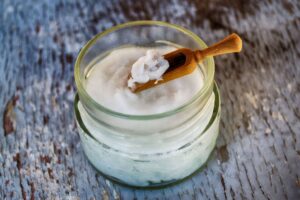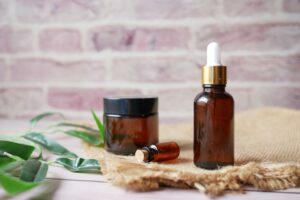Gentle Remedies, Lasting Relief

Seborrheic dermatitis, a common skin condition characterized by redness, itching, and flaking, can be both uncomfortable and challenging to manage. While there are various medicated treatments available, the soothing touch of nature offers a gentle and holistic approach to alleviating symptoms. In this comprehensive guide, we’ll explore the wonders of natural treatments for seborrheic dermatitis, embracing the harmony of botanical solutions that nourish, calm, and restore balance to the skin.
Seborrheic dermatitis is a chronic skin condition that primarily affects areas rich in oil glands, such as the scalp, face, and chest. Common symptoms include redness, inflammation, itching, and flaking of the skin. While the exact cause is not fully understood, factors such as genetics, immune system response, and the presence of a yeast called Malassezia may contribute to its development.
Natural Treatments
- Tea Tree Oil: Known for its potent antifungal and antibacterial properties, tea tree oil can help combat the yeast responsible for seborrheic dermatitis. Dilute a few drops of tea tree oil with a carrier oil, such as coconut or jojoba oil, and apply it to the affected areas. It’s essential to patch test first and avoid using it undiluted, as it can be potent.
- Coconut Oil: The moisturizing and anti-inflammatory properties of coconut oil make it a popular choice for soothing seborrheic dermatitis symptoms. Apply a small amount of organic, cold-pressed coconut oil to affected areas to reduce redness and scaling.
- Aloe Vera Gel: Aloe vera’s soothing and anti-inflammatory qualities can provide relief for irritated skin. Apply pure aloe vera gel directly to affected areas for a calming effect. Ensure that the aloe vera used is free from added chemicals or dyes.
- Apple Cider Vinegar: Apple cider vinegar has antimicrobial properties that can help control the overgrowth of yeast on the skin. Mix equal parts of water and apple cider vinegar and apply it to affected areas with a cotton ball. It’s important to dilute the vinegar to avoid irritation.
- Honey: Raw honey possesses antibacterial and anti-inflammatory properties, making it a gentle option for managing seborrheic dermatitis. Apply a thin layer of honey to affected areas, leave it on for 20-30 minutes, and then rinse thoroughly.
- Oatmeal Baths: Colloidal oatmeal baths can provide relief from itching and inflammation associated with seborrheic dermatitis. Grind plain oatmeal into a fine powder and mix it into a warm bath. Soak for 15-20 minutes to soothe irritated skin.
- Chamomile Tea Compress: Chamomile has anti-inflammatory and calming properties that can benefit seborrheic dermatitis-prone skin. Brew chamomile tea, let it cool, and use it as a compress on affected areas to alleviate redness and discomfort.
- Jojoba Oil: Jojoba oil closely resembles the skin’s natural oils and is well-tolerated by most skin types. Its moisturizing properties can help manage seborrheic dermatitis symptoms. Gently massage a few drops of jojoba oil onto affected areas.
- Probiotics: Incorporating probiotics into your diet may help support a healthy balance of gut bacteria, potentially reducing inflammation associated with seborrheic dermatitis. Consider including probiotic-rich foods like yogurt, kefir, and fermented vegetables.
- Avocado Mask: Avocado is rich in vitamins and fatty acids that can nourish and moisturize the skin. Mash ripe avocado and apply it as a mask on affected areas for 15-20 minutes before rinsing.
Lifestyle Tips for Managing Seborrheic Dermatitis
- Gentle Cleansing: Use a mild, fragrance-free cleanser to cleanse the affected areas, avoiding harsh soaps that may exacerbate irritation.
- Avoid Triggers: Identify and avoid factors that may trigger seborrheic dermatitis flare-ups, such as stress, cold weather, or certain skincare products.
- Sun Protection: Protect your skin from the sun, as sunburn can worsen seborrheic dermatitis symptoms. Use a broad-spectrum sunscreen with an SPF of 30 or higher.
- Manage Stress: Stress can contribute to flare-ups, so incorporating stress-reducing activities such as meditation, yoga, or deep breathing exercises may be beneficial.
- Stay Hydrated: Adequate hydration supports overall skin health. Ensure you’re drinking enough water throughout the day.

When to Seek Professional Advice
While natural treatments can be effective for managing seborrheic dermatitis symptoms, it’s essential to consult with a dermatologist if:
- Symptoms persist or worsen despite home remedies.
- The condition affects a large area of your body.
- There are signs of infection, such as increased redness, swelling, or oozing.
A dermatologist can provide a comprehensive evaluation and recommend appropriate medical treatments if needed.
By embracing the botanical wonders that nature provides, you can soothe, nourish, and harmonize your skin, finding relief from the discomfort of seborrheic dermatitis. Whether it’s the antibacterial properties of tea tree oil, the calming effects of chamomile, or the moisturizing touch of coconut oil, nature’s symphony offers a diverse and holistic approach to promoting skin health. Let the soothing melodies of natural treatments guide you on a path to balanced, comfortable, and radiant skin.

